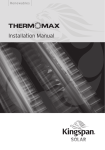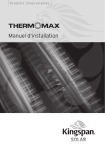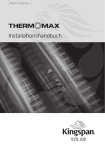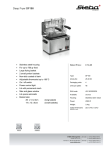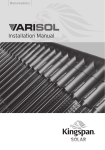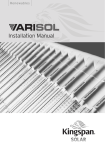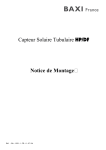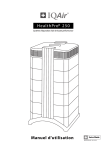Download Installation Manual
Transcript
Re n ewa b l es Installation Manual Themomax Installation Manual Contents Introduction Using this guide Kit components Important pre-installation information 1 1 2 3 Roof kits Overview Sloping Roof Kit Bolt down roof kit Surface mount 35-55 Sloping roof 20 elevated Sloping roof kit horizontal Surface mount 90 horizontal Surface mount 0 and 90 vertical Standing seam metal roof kits 4 5 6 7 8 9 10 11 12 Connection Information Connection kit and other connections Pump station Safety vessel connections Interconnection kit Inserting the tubes Wiring the control panel Comissioning the system Decommissioning the system Construction materials Servicing and maintenance 14 16 17 18 19 20 22 23 24 26 Technical Information Wind loading Technical Specification Warranty Statement 27 28 29 Introduction Solar hot water systems should be designed and sized correctly before commencing the installation. Proper design will ensure that a system is correctly sized to provide many years of optimised performance and most or all of the required hot water when the most solar radiation is available. However a supplementary heating system such as oil or gas boiler, heat pump or wood boiler is required for months which have less solar radiation. For large systems, Kingspan provide a system design service to its Accredited Installer Network and technical design consultants. Please visit www.kingspansolar.com to locate an Accredited Installer or distributor in your area. Details on how to size a solar system correctly can be found in our “Technical Design Guide” available for download from our website www.kingspansolar.com. This guide will illustrate and explain how a system should be installed to conform with the Kingspan Renewables manufacturer guidelines for the Thermomax product models, namely DF100, HP100 & HP200. Using this guide Stages of a solar installation are described in the following pages, with illustrations where necessary to explain how to install the relevant components, and contains general recommendations and important safety information. Note: Prior to installation, the ‘Technical Design Guide’ should be consulted to correctly specify the system components. Handling Guidance •Tube and manifold boxes should be transported horizontally. •Heavy goods should not be loaded on top of the kit boxes. •Care should be taken when opening boxes to prevent scratches or sudden shocks to the glass. •Do not use sharp objects to open the tube boxes. Installation Guidance •Unpack and install tubes only after the manifold and pipe work has been installed. •With the HP200 and HP250 only, tubes may be installed after the system has been filled, pressure tested and is ready for operation. •Do not leave the solar collector exposed to solar radiation when the solar loop and manifold have been drained. Collectors left exposed in a dry state must be covered to prevent possible long term damage. •HP tubes must have a minimum elevation of 20˚ and a maximum of 70˚. •The dark blue side of the copper within the tube is the active surface. •For DF100 system, a heat dissipation loop (heat dump) is recommended - please refer to pages 38-42 of the technical design guide. •The pipework of the solar collector loop is to be earthed and the collector is to be lightening protected in accordance to local regulations. For further technical support please contact the following numbers, Ireland - 1800 812 718 or UK – 0845 812 0007. Health and Safety Precautions A solar panel installation must be performed in accordance with all Health & Safety legislation and local building/planning regulations for the relevant jurisdiction. Furthermore, the necessary electrical work required to install control equipment should be undertaken by a qualified electrical contractor. 01 Themomax Installation Manual Standard Kit Components 02 Dual Stream Pump Station SC100 Controller Sloping Roof Kit with Brackets Connection Kit Flexi Connections Expansion Vessel Manifold & Tube Holders Cooling Vessel (DF100 only) Tyfocor® LS Additional Components Solar Roof Flashing Interconnection Kit 22mm Thermostatic Mixing Valve Note - 28mm also available Insulated Hose Mounting Set 22mm 3 Port Diverter Valve Note - 15 & 28mm also available Stubfitting Important Pre Installation Information Sizing of safety equipment Component sizes are relative to the volume of liquid in the system. Therefore it is important that the Thermomax ‘Technical Design Guide’ is consulted for each system. Pipe Sizing (minimum of 15mm diameter pipework must be used) Collector Pressure Drop HP100 (mbar) Model Size Pipe Diameter Copper External (mm) Capacity (Ltrs) HP100 2 20120 Tube 30 Tube 151.2 1.7 8.54 1.18 4.11 3 HP200 180 20 Tube 30 Tube 240 15 1.1 1.7 15 12.57 2.87 10.47 17.08 2.36 8.22 DF100 5 20 Tube 30300 Tube 3.8 225.6 21.11 4.05 14.58 FN 2.0 6 Flat Panel 360 221.7 25.14 5.74 20.94 22 33.68 6.92 25.05 Collector Volumes Collector Flow Rate Area Ltr/hr (m2) 4 8 240 DF100 (mbar) HP200 (mbar) Expansion Vessel Sizing Model Collector Area (m2) System Volume (Ltrs) Static Height Vessel Size HP100 2 3 4 5 17 17 18 19 5 5 5 5 18 18 18 18 HP200 2 3 4 5 17 17 18 19 5 5 5 5 18 18 18 18 DF100 2 3 4 5 19 20 22 24 5 5 5 5 18 25 25 35 Cooling Vessel Sizing (only required with DF100 systems) It is strongly recommended that a cooling vessel is used with the DF100 collector to protect the expansion vessel from stagnation temperatures. Cooling Vessel Sizing Model DF100 Collector Area (m2) 2 3 4 5 System Volume (Ltrs) 19 20 22 24 Static Height 5 5 5 5 Vessel Size Cooling Vessel Size 18 25 25 35 5 8 8 12 03 Themomax Installation Manual Roof Kits 04 Standard Roof Fixings The Thermomax product range is available with a choice of roof fixing options to suit many roof types, see diagram below for the most common fixings. The most common fixings are illustrated and explained in the following section and may be easily secured to slate, tile or masonry finishes. Roof kits and their relevant manufacturer codes: Option Code 4 1 5 3 6 2 8 7 Suitable for HP Suitable for DF 1 or C0590 Sloping roof kit V KSK0012 Bolt down roof kit Description Y Y Y Y 2 C0599 Flat roof ‘A’ frame kit (35˚– 55˚) Y Y 3 C0591 Sloping roof 20˚ elevation V Y Y 4 C0593 Sloping roof kit H N Y 5 C0597 Façade kit H N Y 6 C0595 Façade kit V N Y 7 C0595 Façade kit V N Y 8 KSK0018 Awning roof kit Y Y Horizontal Installations (DF100 only) With any DF100 installation where the collector is installed horizontally on a wall façade or roof surface; the airvent on the collector manifold must be the highest point of the collector, otherwise air in the system will remain in the pipes within the collector tubes and be difficult to flush out. Airlocks in the pipes will stop circulation through the system. When the collector is orientated correctly, i.e. with the manifold slightly higher than the base of the collector, (see below) air will be forced back into the system. In this instance the air separator will prevent air from circulating. Flat horizontal orientation (option 6 above) Wall horizontal installation (option 5 above) Minimum 2˚ angle Metal Roof Fixings Kingspan also supply roof fixing kits for metal and other commercial roofs. Two options available utilise appropriate clamps so the fabric of the metal roof is not penetrated - see page 12. Note the minimum and maximum distances on each fixing kit. The distance between the vertical rails on each fixing kit should be between 600mm1100mm on 20 tube systems and 800-1400mm on 30 tube systems. This is illustrated on each roof kit diagram. Note that the fixing clamps on the side rails are preset for ease of on-site installation. C0590 – Sloping Roof Kit In high wind load areas e.g. at excessive heights or very exposed areas when the force acting upon the solar panel is greater than 2.5kN/m², an additional vertical support rail (C0594) may be obtained. Please refer to the wind loading table – page 27. On the sloping roof kit, a distance of 1400mm (minimum) and 1700mm (maximum) should be observed between the top of the lower brackets and the top of the upper brackets. mm 00 -17 00 14 60 80 0-11 0-1 00 40 mm 0m m (20) (30 ) 1. Slide back tile and attach lower brackets to roof rafter 2. Secure side rails to lower bracket with the pre-drilled holes to the bottom 3. Attach upper brackets to roof rafters 4. Secure side rails to upper brackets with sliding bolt fixing 5. Locate manifold on side rails and secure with upper clamp bolts 6. Locate horizontal support rails on the side rails 05 Themomax Installation Manual KSK0012 – Bolt down Roof Kit 06 This roof kit may be used to secure directly through tile or slate surfaces. 60 80 0-11 0-1 00 40 mm 0m m (20) (30 ) mm 00 -17 00 4 1 1.Locate the rafters beneath the roof material and drill to a depth of 120mm with a 12mm drill bit. 2.Insert the rawl plug provided if necessary and fix the bolt with a spanner. 3. Locate the nut above the rubber roof seal and tighten to ensure a good seal is made on the fixing surface. 4.Stabilise the flat fixing plate by tightening the attached nuts above and below the plate. 5.Attach the roof rails to the four fixing plates using the bolts provided. C0599 – Surface mount 35˚ to 55˚ In high wind load areas e.g. at excessive heights or very exposed areas when the force acting upon the solar panel is greater than 2.5kN/m², an additional vertical support rail (C0596) may be obtained. Please refer to the wind loading table – page 27. 07 B B A 6001 800- 100mm (2 1400 mm 0) (30) A mm 1400 1. Attach front and rear brackets to surface at distance shown 2. Secure side rail to front bracket 3. Secure side rail to rear bracket 4. Secure side bracing bracket to side rail 5. Adjust and secure rear brace 6. Locate manifold on side rails 7. Locate support rails on side rails Themomax Installation Manual C0591 – Sloping Roof Kit 20˚ Elevated 08 15 50 -2 05 0m m 18 00 mm 1. Attach brackets to roof at distance shown over 6001 800- 100mm (2 1400 mm 0) (30) 2. Assemble hinge brackets to roof brackets at distance shown over 3. Secure side rail to lower bracket 4. Secure rear strut to upper bracket 5. Adjust and secure side brace 6. Attach and secure rear brace 7. Locate manifold on side rails 8. Locate support rails on side rails C0593 – Sloping Roof Kit Horizontal 09 Note – Only the DF100 can be mounted in this horizontal position. Drill required 70 0-1 40 0m m ) (20 ) m (30 0m m 10 00m 1 4 0 90 00-1 12 1. Attach brackets to roof at distance shown 2. Secure side rails to brackets 3. Locate locking pin positions and drill holes 4. Secure locking pins to prevent slippage 5. Locate manifold on side rails 6. Locate support rails on side rails Themomax Installation Manual C0597 – Surface Mount 90˚ Horizontal 10 Note – Only the DF100 can be mounted in this horizontal position. 18 50 mm ) (20 ) 0 m 0m m (3 0 1 m 0-1 00 60 0-14 80 1. Attach brackets to surface at distance shown above 2. Attach side rails to brackets using bolts provided 3. Locate locking pin position on manifold and support rails and drill holes 4. Locate support rails on side rails 5. Locate manifold on side rails 6. Secure clamps C0595 – Surface Mount 0˚ & 90˚ Vertical Note – Only the DF100 can be mounted in a horizontal or vertical position. 60 80 0-11 0-1 00 40 mm 0m m (20) (30 ) mm 50 18 1. Attach brackets to surface at distance shown above 2. Attach side rails to brackets using bolts provided 3. Locate manifold on side rails 4. Secure all clamps 11 Themomax Installation Manual Standing Seam Metal Roof Kit 12 This roof kit may be used to secure directly onto standing seam roof types. A metal roof kit requires a joint plate kit (KSK0016) comprising two vertical side rails and adjustable plate connections. The roof type will determine the clamp required. The following metal roof clamps are for use with the ‘joint plate kit’ KSK0016: KSK0025 – Bulb standing seam KSK0026 – Double folded standing seam 60 80 0-11 0-1 00 40 mm 0m m (20) (30 ) KSK0025 – Bulb Standing Seam Clamps mm 00 -17 00 4 1 KSK0026 – Double Folded Standing Seam Clamps 13 1. Locate and secure the standing seam clamps at the appropriate distances indicated and attach the joint plate to the standing seam clamp as shown. 2. Attach the side rails to the joint plate as shown. 3. Locate manifold on side rails 4. Secure all clamps Themomax Installation Manual Connection Information 14 In any solar panel system, the ‘return’ refers to the intake in the collector where liquid is returning to be reheated. The ‘flow’ refers to the collector side where the liquid is flowing to the heat exchanger. Note: It is essential that the collector temperature sensor is located in the flow of the collector. The following illustration shows the connections to the manifold. Return connection Manual airvent Manifold clip Female assembly Flow connection Male assembly Sensor pocket 1. Tighten compression fitting to connection fitting (flow and return) 2. Tighten compression fitting to pipe work (flow and return) 3. Attach assembled fittings to manifold 4. Push clip all the way down until connection is fully retained 5. Pull gently on assembly to ensure proper engagement and retention Types of Connections The only pipes which should be used with a solar installation are copper pipe, continuous flexible stainless steel or mild steel. When using copper pipe, only compression or brazed joints can be used. Solder and galvanised fittings will not withstand high temperature or expansion and are therefore not suitable for solar pipe work. PEX / PLASTIC / PEX-ALU-PEX or GALVANISED TUBING OR FITTINGS SHOULD NOT BE USED UNDER ANY CIRCUMSTANCES Flexible Pipe Connections Flexible pipe connections are recommended to connect the manifold through the building fabric and allow flexibility in connecting to the internal pipe work. Flexible stainless steel pipes are available in both a 15mm and 22mm diameter. If connecting one diameter pipe to another, a suitable reducer compression fitting is recommended to make the connection. Insulation All pipe work on the solar loop should be insulated with high temperature insulation (such as HT/Armaflex from Armacell GmbH). High temperature insulation is essential as regular pipe insulation will melt at temperatures experienced by solar pipes. The wall thickness of the insulation should be equal to the diameter of the pipe. The only pipes which should not be insulated are the pipes to the safety vessels as they should allow heat to dissipate when the system is experiencing excessive heat and pressure. 15 Themomax Installation Manual Pump Station 16 The Kingspan Solar Thermomax product range offers both a single stream and a dual stream pump station. Each pump station is available in two flow rates, 2-12 litres and 8-28 litres. The flow rate required on a system is typically 1 litre per minute, per square metre installed. Therefore a 2-12 litre pump station will be sufficient for systems up to 12m². 9 6 6 9 13 10 8 7 7 5 11 13 10 8 5 12 4 12 2 3 4 2 3 1 9 1 Key 1 Drain connection 2 Fill connection 3 Flow meter 4 Isolating valve 5 Motorised pump 6 6 bar pressure relief valve 7 Expansion vessel connection 8 Pressure guage 9 22mm connections (x 4) 10 Temperature guage 11 Air separator 12 Insulated fascia 13 Pressure relief discharge point 9 Connections of flow and return pipe work to the pump station are made with the straight compression fittings provided for direct copper connection. C0784 – Insulated Hose Stub Fitting When flexible stainless steel pipe is being used to connect to the pump station, the insulated hose stub fitting is required to make the connection. The split ring within the fitting should be removed and placed over the second rib of the flexible pipe. When the compression fitting is tightened, the split ring will click twice as it positions itself and locks inside the fitting. C0785 – Insulated Hose Clamp Ring When the short flexible connection is being joined to stainless steel pipe work, the insulated hose clamp ring is required to make the connection. The split ring within the fitting should be removed and placed over the second rib of the flexible pipe. When the compression fitting is tightened, the split ring will click twice as it positions itself and locks inside the fitting. Safety Vessel Connections Pressure Relief Valve (PRV) Rated at 6 bar, the PRV may discharge heat transfer fluid (Tyfocor® LS) which must be channelled into a container capable of withstanding high temperature discharge and containing the total collector volume. The container should be secured so it cannot be removed or spilled. The PRV should not be channelled into a drain or any pipe work which will allow it to enter the normal water course. Fitting the expansion vessel: It is recommended that the expansion vessel is located below the level of the connection from the pump station to prolong its life. The expansion vessel supplied includes an appropriate corrugated hose and threaded connection to join the vessel to the pump station. Temperature Reducing Vessel (TRV) Also known as a ‘cooling vessel’ or ‘stratification vessel’, the TRV is highly recommended with the Thermomax DF100. Due to high temperatures which can be experienced within the solar loop, the TRV allows for additional expansion and reduces the temperature of the heat transfer fluid before it enters the expansion vessel. Fitting the TRV: With the direct flow vessel kit, which includes the TRV, a corrugated hose assembly is included to join the expansion vessel to the TRV from the pump station. 1 6 2 TRV 4 3 2 5 1 2 3 4 5 6 PRV discharge point Wall bracket (supplied) Discharge container TRV kit (DF100 only) Expansion vessel Dual stream pump station 17 Themomax Installation Manual Interconnection Kit (Product Code C0674) 18 When joining more than one manifold together, it is necessary to use the interconnection kit which will support and align multiple collectors. All manifolds comprise a male and female connection, enabling manifolds to be connected without the need for additional pipework. The maximum number of manifolds which may be connected in series before connecting in parallel is shown in the table below: Model DF100 x 30 tubes HP100 x 30 tubes HP200 x 30 tubes Max. Number of collectors 5 6 4 1.Insert screws into plate ensuring screws do not protrude to upper side 2.Slide plate approximately half way into channel at bottom of manifold that is fixed to side rails 3.Tighten up screws to force plate against bottom of manifold (do not overtighten) 4.Slide channel of next manifold on plate 5.Push clip all the way down until connection is fully retained 6.Assemble support rail connection plate to fixed support rails 7.Assemble retaining plates and fittings Inserting tubes DF100 Tubes 1.Open manifold lid by removing front seal strip 4 1 2.Place tube in tube clips on both support rails 3.Slide tube into manifold connection while slightly rotating tube until washer on bellow sits flush against manifold fitting. Do not apply force, if any problems are experienced, check alignment of support rails to manifold. 2 4.Insert tube retaining clip to secure tube to manifold and rotate clip 360˚ to ensure a good connection. 6 3 7 5.Gently pull on tube to ensure secure assembly. 6.Close tube retaining rubber on both support rails. Repeat steps 2 to 6 for all tubes. 3 5 7.Close manifold lid ensuring proper engagement of front seal strip over whole length and on end caps. HP100 or HP150 Tubes 1.Open manifold lid by removing front seal strip as shown on manifold end cap 2.Place tube in tube clips on both support rails 5 3.Slide tube into manifold connection while slightly rotating tube until a clicking noise is heard. Do not apply force. If tube does not engage properly, support the tube at the bellow section while pushing into the manifold connection until it clicks into position. 4.Gently pull on tube to ensure secure assembly. 1 5.Close tube retaining rubber on both support rails. Repeat steps 2 to 5 for all tubes. 3 4 3 6.Close manifold lid ensuring proper engagement of front seal strip over whole length and on end caps. HP200 or HP250 Tubes 1.Open manifold lid by removing front seal strip as shown on manifold end cap 2.Place tube in tube clips on both support rails 3.Slide tube into manifold connection while slightly rotating tube until TWO clicking noises are heard. Do not apply force. If tube does not engage properly, support tube at bellow section while pushing into the manifold connection. 1 3 5 4.Gently pull on tube to ensure secure assembly. 5.Close tube retaining rubber on both support rails. Repeat steps 2 to 5 for all tubes. 3 4 6.Close manifold lid ensuring proper engagement of front seal strip over whole length and on end caps. 19 Themomax Installation Manual Wiring the Solar Control Panel 20 All electrical aspects of the installation should be undertaken by a qualified electrician. Note that for safety, the pump and sensor connections should always be wired prior to connecting power to the solar control panel. IMPORTANT: The solar control panel must have a permanent electrical power supply which must not be interrupted either manually or with a time switch. If the permanent electrical supply to the building is to be switched off for any period of time, the solar collector(s) should either be covered, or the system drained and the tubes removed. In order to protect the normal operation of the control panel, it should be located at least 100 mm from insulated pipes which may become hot during operation. Control panels use PT1000 sensors containing twin core copper cable with a 0.75mm cross section. The sensors supplied are 1.5 metres in length. Sensor cables can be extended with twin core copper cable of 0.75mm diameter up to 50 metres and 1.50mm diameter between 50-100m. Screened cable should be used on the sensor cables to prevent RFI from electrical cables. All connections to extend the cables should be housed in a junction box for protection. The following diagrams show the connection of the solar pump and other relays on the SC range of controllers. This should be read in conjunction with the Installation and Operation Manual supplied with each SC control panel. Power Supply Connection: Sensor Connection The connection of PT1000 sensors is as shown below. The polarity of the sensor cables is not relevant on each sensor. The SC100 has four inputs as illustrated below. However the SC200 and SC300 can receive five and six sensors respectively (for larger system design) and are connected in the same way. Input connection for 1-4 sensors: Connection of first output/pump (R1) R1 of the SC controllers comprises a semiconductor relay (TRIAC), also suitable for RPM control with a maximum switching current displayed on the unit type plate. Both the SC100 and the SC200 contain an electromechanical relay, R2. Note that the SC300 contains two RPM relays, R1 and R2 as well as an electromechanical relay, R3. The SC200 and SC300 are therefore suitable for controlling two pumps i.e. for an east/west panel array or a stagnation configuration requiring a second pump. Caution Avoiding damage and malfunctions – When connecting an external relay or contactor, or when connecting a pump which has its own electronic RPM control, the controller output’s RPM control must be deactivated (see “Setting the RPM control parameters” in the Controller Manual). Connection of second output (R2) if required R2 on the SC100 contains a switched output via an electromechanical relay with a maximum switching current displayed on the unit type plate. Note the wire bridge (D1) must be connected. 21 Themomax Installation Manual Commissioning the System 22 Inserting the tubes The evacuated tubes should be inserted at a time when there is very low light such as late afternoon when the sun is low and not particularly strong. Alternatively the tubes should be covered. This is important as tube connections can heat up considerably in a short space of time and have potential to cause injury while the glass temperature will remain low. Please refer to page 17 for information on tube connection into the manifold. Expansion Vessel IMPORTANT: Prior to filling the system, the expansion vessel pressure must be set 0.3 Bar below the system pressure. Omitting to perform this check will result in irregular pressure readings during the commissioning of the system. The pressure is checked at the base of the vessel and the bleed valve may be bled or topped up with a pump. Filling the Loop It is important that a motorised flush and fill centre is used to fill and pressurise the system with Tyfocor® LS as follows: 1. Open the fill and drain valves to allow the liquid to circulate around the solar loop 2. Turn the hot and cold temperature gauges 45˚ clockwise. 3.Close the isolating valve above to the flow meter to ensure all air and liquid passes through the fill centre to filter any air and contaminants. 4. Run the fill centre pump to circulate the Tyfocor® LS for approximately 20 minutes. 5.Open and close the isolating valve intermittently to circulate air bubbles which may accumulate in the sight glass. 6. Return isolating valve to closed position. 7.When the solar loop has been purged of air, close the bottom/drain connection – the fill centre will begin to pressurise the solar loop 8. Reopen the isolating valve above the flow meter fully. 9. Fill the loop until the pressure gauge just exceeds the required pressure and stop the pump and immediately close the fill connection. Check pipe joints on the solar loop for leaks and check that pressure is not lost over a 30 minute period. 10.If all the plumbing is sound, set the system pressure by opening the return connection until the required pressure is met. 11.Return the temperature gauges to the original position. 12.The fill centre may now be disconnected. 13.Cap the fill and drain points with the brass covers provided. The pipes from the flush and fill centre should be connected as shown in the diagram below: FILL DRAIN FLUSH AND FILL CENTRE Setting the flow rate The pump may only be run when the system has been filled as dry operation will damage the pump. The desired flow rate is 1 litre per minute per m² (10 tubes=1m²). 1.Set the pump to the first speed and run it manually from the controller (see following paragraph). 2.If the desired flow rate is exceeded, set the flow meter to the desired rate by adjusting the isolating valve with a flat headed screwdriver (see diagram) with the pump running. Otherwise repeat this step at the next pump speed and continue until the desired flow rate is achieved 3. Stop the pump. OPEN CLOSED ISOLATING VALVE Left side view of controller Operating the pump in ‘Manual’ mode (for SC range controllers) In order to run the pump in ‘Manual’ mode, slide the operating switch on the left side of the solar control panel to the upper of the three positions. On the screen, select the appropriate relay with the up/down arrows and press the ‘Set’ button to run the relay and to switch it off again. Other Relays If any additional relays are set up on the system, these should be tested in ‘Manual’ mode as above, to ensure the connections have been wired correctly. Decommissioning the System Due to temperatures potentially exceeding 170˚C and pressures greater than 6 bar, a solar installation should only be decommissioned by a trained individual. The system should be decommissioned in low light, ideally in the morning when the solar loop should be coolest. 1. Electrical • Isolate controller from mains • Remove cables to consumer units i.e. controller and pump • Remove sensors and associated cables • Remove earthing cables 2. Collector Loop • Beware of hot transfer fluid • Drain collector loop at drain valve. Contain the heat transfer fluid for appropriate disposal. • Disconnect pipes from the manifold 3. Collector (Beware of high temperatures) • Remove rubber retainer to release manifold lid • Unclip tube • Remove the rubber support retainers from around glass tube • Remove tube manifold clip • Remove tubes from manifold • Remove lid and separate materials • Remove Manifold and support rails and separate materials • Remove roof kit and separate materials • Reinstate roof Disposal Dispose of separate materials in accordance with local regulations. Please see the following pages for details of materials used in the construction of Thermomax collectors and guidance on disposal of antifreeze. 23 Themomax Installation Manual Construction Materials 24 1 2 3 4 5 6 7 8 9 10 11 DF100 Aluminium EPDM Brass Bronze Stainless Steel PA66 30% GF Silicon Vinyl Copper Melamine Glass HP100 1 2 3 4 5 6 7 8 9 10 11 Aluminium EPDM Brass Bronze Stainless Steel PA66 30% GF Silicon Vinyl Copper Melamine Glass 25 HP200 1 2 3 4 5 6 7 8 9 10 11 Aluminium EPDM Brass Bronze Stainless Steel PA66 30% GF Silicon Vinyl Copper Melamine Glass Disposal of Solar Anti-Freeze Solution The solution we supply with our solar systems is a thermal transfer fluid based on 1,2 propylene glycol and water. The solution also contains corrosion inhibitors and has been specifically designed for used in solar systems with elevated temperatures, such as those experienced with Vacuum Tube Collectors. Propylene Glycol is a widely used ingredient in pharmaceutical, food, cosmetic, personal care, flavours and animal feed applications. Propylene glycol is not volatile, but is miscible with water. Propylene glycol is not harmful to aquatic organisms and is readily biodegradable; however the disposal of the solution should be done in a responsible manner taking into consideration local Environmental and Health & Safety legislation. While the solution is not subject to registration as a hazardous material according to EEC directives the solution should be disposed of by special means. There are a number of specialist companies that can deal with the disposal of propylene glycol. A list of these companies is available upon request. A copy of the EEC Safety Data sheet and Technical Information sheet is available upon request. We recommend that you contact your local authority to check that they will accept the solution at special landfill collection points. There are a number of specialist companies that can deal with the disposal of propylene glycol, a list is available on request: [email protected] Themomax Installation Manual Servicing and Maintenance 26 Users should regularly check the temperatures which the solar control panel is recording. With the SC range of controllers, simply pressing the ‘SET’ button on the fascia once will display the upper and lower collector temperatures since the control panel was last reset. If the collector temperatures have been excessively high i.e. over 170˚C, it is recommended that the antifreeze level be checked using a refractometer by a qualified engineer. A sample of the Tyfocor® LS antifreeze fluid can be extracted from the pump station at the pump itself. The large centre of the pump hub can be opened with a large flathead screwdriver. This should be opened slowly until a few drops of the antifreeze fluid are released. A sample of the fluid placed on the glass of the refractometer will display the level of antifreeze in the system. If the antifreeze has lost its antifreeze properties the system should be refilled with fresh Tyfocor® LS. It is recommended that the solar system is serviced annually by a qualified engineer and immediately if the system shows evidence of having lost pressure or has discharged liquid at the pressure relief valve. The Tyfocor® LS antifreeze fluid should always be replaced after 7 years. Maintenance schedule A qualified person should service the system at the recommended intervals, using the maintenance schedule below. In addition the user should check the system pressure at regular intervals. A visual inspection of the pressure gauge is required to check that the system pressure is maintained at the level noted below. The service engineer should complete the following; the shaded boxes should be completed if the system requires refilling: Upon commissioning Year 1 Year 2 Year 3 Year 4 Year 5 Date of inspection Expansion vessel setting before filling System pressure Expansion vessel setting after filling Flow rate Antifreeze level pH reading Inspection of barium getter on tubes Engineer details Print name Sign Telephone No. Year 6 Year 7 Technical Information Wind Loading 27 Stress and maximum load on the substance on flat roofs to DIN 1055 Prevention of Collector Slippage 25° Prevention of Collector Lifting Weight Per Foot (kg) Weight Per Foot (kg) 10 Tube Collector Height Above Ground (m) A B 8 76 8 to 20 129 20 Tube Collector 30 Tube Collector 10 Tube Collector A B A B A 102 76 102 116 155 178 129 178 195 269 20 Tube Collector B A 26 65 57 125 30 Tube Collector B A B 26 65 41 100 51 125 80 191 Stress and maximum load on the substance on flat roofs to DIN 1055 Prevention of Collector Slippage 45° Prevention of Collector Lifting Weight Per Foot (kg) Weight Per Foot (kg) 10 Tube Collector 20 Tube Collector 30 Tube Collector 10 Tube Collector 20 Tube Collector 30 Tube Collector Height Above Ground (m) A B A B A B A B A B A B 8 102 171 102 171 156 256 73 73 73 73 111 111 8 to 20 177 287 177 287 266 430 137 137 137 137 206 206 A - Front feet B - Back feet See page 7 for diagram Technical Specification DF100 HP100 HP200 10 20 30 20 30 10 20 30 1996 x 709 x 97 1996 x 1418 x 97 1996 x 2127 x 97 2045 x 1418 x 97 2045 x 2127 x 97 2005 x 709 x 97 2005 x 1418 x 97 2005 x 2127 x 97 Weight [kg] 36.9 54.8 81.4 47.2 70.5 33.2 50.3 75.1 Volume [l] 2.6 3.8 5.6 1.2 1.7 0.83 1.2 1.7 Max. Field Size [m²] 10 12 15 16 18 8 10 12 Dimensions (Length x Width x Height) [mm] Cu Pipe Diameter 2-3m² [mm] per panel area 15mm x 1 22mm x 1 28mm x 1.2 35mm x 1.5 4-9m² 10-15m² 16-20m² 8 Max. Operating Pressure [bar] Min. Slope [°] Max. Slope [°] 0 90 20 70 2.5 Max. Load [kN/m²] (DIN 1055-5) Heat Transfer Medium Propylene Glycol suitable for evacuated tube collectors Pressure Drop Curves 14 0 HP 20 0-2 0 HP 20 0-3 0 12 0 HP 10 0-2 0 HP 10 0-3 0 10 0 80 p [mbar] 60 Δ 40 20 0 0 2 4 6 V [ l /m i n ] 8 10 12 Themomax Installation Manual Technical Specifications 28 DF100 HP100/150 HP200/250 1m² 2m² 3m² 2m² 3m² 1m² 2m² 3m² Number of Tubes 10 20 30 20 30 10 20 30 Dimensions Absorber Area (m²) 1.002 Overall Dimensions (mm) 1996x709x97 1996x1418x97 1996x2127x97 2005x1418x97 2005x2127x97 2005x709x97 2.004 3.020 2.006 3.009 1.007 2005x1418x97 2005x2127x97 2.01 3.021 Width of Manifold (mm) 709 1418 2127 1418 2127 709 1418 Length (tube and manifold) (mm) 1996 1996 1996 2005 2005 2005 2005 2005 Depth (mm) 97 97 97 97 97 97 97 97 2127 Aperture Area (m²) 1.07 2.15 3.23 2.16 3.24 1.07 2.16 3.23 Fluid Volume (ltr) 1.8 3.6 5.6 1.2 1.7 0.6 1.1 1.7 Inlet and Outlet Dimensions (mm) 22 22 22 22 22 22 22 22 Weight (empty) (kg) 54.8 81.4 47.2 70.5 25 50.3 75.1 25 Mounting Recommended Inclination (˚) 0-90 0-90 0-90 20-70 20-70 20-70 20-70 20-70 Performance Data Efficiency Based on Aperture Based on Aperture Based on Aperture Based on Aperture Based on Aperture Based on Aperture Based on Aperture eta 0 0.773 0.773 0.773 0.739 0.739 0.726/0.761 0.726/0.761 0.726/0.761 k1 (W/m²K) 1.45 1.45 1.45 1 1 1.55/1.36 1.55/1.36 1.55/1.36 k2 (W/m²K²) 0.0059 0.0059 0.0059 0.0074 0.0074 0.0058/0.0074 0.0058/0.0074 0.0058/0.0074 Based on Aperture Solar Keymark Licence Nos 011-7S060R 011-7S314R HP200 - 011-7S125R HP250 - 011-7S904R Operating Data Flow Rate (ltr/h) Rated 80 160 240 160 240 80 160 240 Minimum 60 120 180 120 180 60 120 180 Maximum 150 300 480 300 480 150 300 480 Maximum Operating Pressure 8 Bar 8 Bar 8 Bar 8 Bar 8 Bar 8 Bar 8 Bar 8 Bar Stagnation Temperature (˚C) 286 286 286 166 166 184/217 184/217 184/217 Heat Transfer Fluid Water/Glycol Water/Glycol Water/Glycol Water/Glycol Water/Glycol Water/Glycol Water/Glycol Water/Glycol Materials Absorber Copper Coating Selective Coating Selective Coating Selective Coating Selective Coating Selective Coating Selective Coating Selective Coating Selective Coating Copper Copper Copper Copper Copper Copper Copper Absorbance (%) 95 95 95 95 95 95 95 95 Emissivity (5) 5 5 5 5 5 5 5 5 Mounting Frame and Clips Stainless Steel, Stainless Steel, Stainless Steel, Stainless Steel, Stainless Steel, Stainless Steel, Stainless Steel, Stainless Steel, Aluminium, Aluminium, Aluminium, Aluminium, Aluminium, Aluminium, Aluminium, Aluminium, EPDM EPDM EPDM EPDM EPDM EPDM EPDM EPDM Glass Low Iron Low Iron Low Iron Low Iron Low Iron Low Iron Low Iron Low Iron - Transm. 0.92 - Transm. 0.92 - Transm. 0.92 - Transm. 0.92 - Transm. 0.92 - Transm. 0.92 - Transm. 0.92 - Transm. 0.92 Vacuum <10-6mbar <10-6mbar <10-6mbar <10-6mbar Temperature Limitation <10-6mbar 95/135 95/135 95/135 95/135 95/135 Quality Certification/ Solar Keymark Yes Yes Yes Yes Yes Yes <10-6mbar Yes <10-6mbar Yes <10-6mbar Warranty Statement Kingspan Renewables Ltd Warranty Statement for Solar Subject to the following provisions, Kingspan Renewables Ltd warrants that the Goods will be free from defects in material and workmanship for a period of 5 years in relation to THERMOMAX SOLAR PRODUCTS. The warranty is given by Kingspan Renewables Ltd subject to the following conditions: A. Kingspan Renewables Ltd shall be under no liability in respect of any defect in the Goods arising from any information drawing design or specification supplied by the Buyer B.Kingspan Renewables Ltd shall be under no liability in respect of any defect arising from fair wear and tear, wilful or accidental damage, negligence, abnormal working conditions, failure to follow the Kingspan Renewables Ltd design and installation instructions, misuse or alteration or repair of the Goods without approval C. The above warranty does not extend to parts materials equipment not manufactured by Kingspan Renewables Ltd in respect of which the Buyer shall only be entitled to the benefit of any such warranty or guarantee as is given by the manufacturer to the Company. D. The defect has been reported by the Buyer to Kingspan Renewables Ltd within the warranty period E. The installation of the Goods having been carried out by fully trained and competent person(s) F. The Goods having been subjected to neither “prolonged stagnation conditions” nor exhibiting signs of “extreme temperature exposure” 1. The Buyer shall not make any statement or representation or give any warranty to any third party in respect of any Goods other than in the terms made or given by Kingspan Renewables Ltd to the Buyer nor shall the Buyer have any authority to commit Kingspan Renewables Ltd to provide any service in relation to the Goods. 2. The Company’s liability to the Buyer for death or injury resulting from its own or that of its employees’ agents’ or subcontractors’ negligence and damage suffered by the Buyer as a result of any breach of the obligations implied by Section 12 of The Sale of Goods Act 1979 shall not be limited. 3. If Kingspan Renewables fails to deliver the Goods for any reason other than any cause beyond the Company’s reasonable control or the Buyer’s fault then Kingspan Renewables Ltd shall only be liable to the Buyer for and the Company’s liability shall be limited to the excess (if any) of the cost to the Buyer (in the cheapest available market) of similar goods to replace those not delivered over the Price of the Goods. 4. The Buyer shall examine all delivered Goods forthwith. Any claim based on any defect in the quality or condition of the Goods or their failure to correspond with specification shall be notified to Kingspan Renewable Ltd within 7 days from the delivery date or where the defect was not apparent on reasonable inspection within a reasonable time after discovery of the failure. If delivery is not refused and the Buyer does not notify Kingspan Renewable Ltd the Buyer shall not be entitled to reject the Goods. 5. Kingspan Renewables Ltd shall be entitled to examine any Goods, which are the subject of any claim by the Buyer, and to remove such Goods or any part thereof for testing. No tests carried out by the Buyer will be recognised by Kingspan Renewables Ltd unless carried out strictly in accordance with a method previously agreed by Kingspan Renewables Ltd as being suitable for the purpose. 6. Any valid claim in respect of the Goods which is based on any defect in the quality or condition of the Goods or their failure to meet specification is notified to Kingspan Renewables Ltd in accordance with these Conditions Kingspan Renewables Ltd shall be entitled to repair or replace the Goods (or the part in question) free of charge or at the Company’s sole discretion refund to the Buyer the Price (or a proportionate part of the Price) but Kingspan Renewables Ltd shall have no further liability to the Buyer. 7. Kingspan Renewables Ltd shall not be liable to the Buyer by reason of any representation (unless fraudulent) or any implied warranty condition or other term or any duty at common law (including but without limitation the negligence of Kingspan Renewables Ltd its employees agents or otherwise) or under the express terms of the Contract for any loss of production loss of profits or anticipated profits loss of contracts operation time or anticipated savings loss of business or of expected further business loss of or corruption to data damage to the Buyer’s reputation or goodwill damages costs or expenses payable by the Buyer to any third party or any other indirect special or consequential loss or damage or claim (whether caused by the negligence of Kingspan Renewables Ltd its employees agents or otherwise) which arise out of or in connection with the supply of the Goods or their use or resale by the Buyer. 8. Without prejudice to the provisions of clauses 3, 4, 5, 6 and 7 the entire liability of the Buyer under or in connection with the Contract shall not exceed the Price of the Goods. 9. Kingspan Renewables Ltd shall not be liable to the Buyer or be deemed to be in breach of the contract by reason of any delay in performing or any failure to perform any of the Company’s obligations in relation to the Goods if the delay or failure was due to any cause beyond the Company’s reasonable control. Without limiting the foregoing, due to causes beyond the Company’s reasonable control. 10.For comprehensive details regarding “Warranties and Liability” please refer to the “CONDITIONS OF SALES” section 7. 29 This brochure is printed on environmentally friendly paper. Kingspan Renewables Limited 180 Gilford Road, Portadown, Co. Armagh, Northern Ireland, BT63 5LF Tel: +44 (0) 28 3836 4500 Fax: +44 (0) 28 3836 4501 E-mail: [email protected] www.kingspansolar.com Due to our continuing policy of development and improvement we reserve the right to alter and amend the specification as shown in this literature.
































